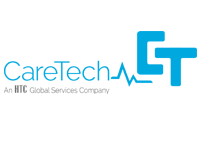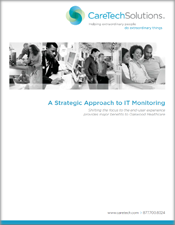Resource:
A Strategic Approach to IT Monitoring:: Shifting the focus to the end-user experience provides major benefits to Oakwood Healthcare
There are many examples of healthcare IT monitoring efforts that have fallen short of delivering on their promise. Stories abound of systems that are cumbersome and time-consuming, and deliver questionable value.
Oakwood Healthcare has a different story to tell. A nonprofit organization in southeast Michigan with four acute-care hospitals, more than 1,200 beds, 1,300 physicians, 9,000 employees and 65 outpatient sites, Oakwood has fine-tuned its IT monitoring approach, breaking past the barriers that many experience to find “game-changing” results.
Why monitoring is critical
With the switch to full reliance on electronic medical records, never has effective system monitoring been more important. Going all-electronic raises the stakes. System users expect and need speed and consistency.
Oakwood’s decision to install Epic software for its new electronic medical records required a significant change in workflow and technology. Going paperless was a stressful situation for IT and medical staff alike.
With a commitment to patient care and end-user satisfaction, Oakwood’s Chief Information Officer, Paula Smith, knew she needed a comprehensive 24x7x365 monitoring solution that would help IT staff avoid unscheduled downtime that could put patient care at risk. The rollout of the new Epic system included 6,000 new devices, relocation to a new data center, and a refresh of the full network infrastructure. “Effectively monitoring a new, enterprise-wide, mission critical medical system against the backdrop of substantial technical and clinical change was absolutely essential to our success.”
Why monitoring efforts fail
The challenges of effective IT system monitoring are well documented. “By some reports, 80 percent of monitoring software is either never implemented or implemented incorrectly,” says Jim Hunter, director, Information Security and Monitoring, CareTech Solutions. “That’s due to a steep learning curve. It takes a lot to get it right.”
A common flaw in monitoring systems is over-alerting. “People adapt and learn how to tune out the noise,” says Hunter. “They create rules for their inbox to filter out the alerts, so when there is an important message, it gets missed. The result is a system that’s ineffective.”
Another common flaw is monitoring for the wrong things. Some monitoring efforts focus on the capacity of individual servers, but with redundant equipment and systems that can dynamically balance loads, as one Oakwood IT staff member said, “The information that we would collect for the amount of effort it took was only marginally of value.”
The four levels of monitoring
- Level 1: You find out about a problem when your customers tell you about it.
- Level 2: You’re seeing the problem the same time your customers do.
- Level 3: When your customers call with problems, you’re able to tell them you’re already working on it.
- Level 4: Problems are solved before your customers ever notice them.
Effective monitoring takes you from Level 1 to Level 4. But how to get there?
Key to success: Shifting the focus
“Shifting from monitoring technology to monitoring what our physicians and nursing staff experience as they use the system,” according to CIO Smith, “underscores our complete focus on improving the patient care environment.”
The starting point was to identify and monitor the work most important to the clinicians – for example, creating a patient list, or the electronic transfer of large critical files to external organizations, as well as the users’ most frequent daily electronic tasks. Backed by CareTech Solutions, Oakwood created “robots,” or computers strategically placed throughout the hospitals and offices to simulate the users’ most common functions on its most critical systems. “Robots are essentially synthetic users,” says Hunter. “The idea is to set up a script just like a user would have with all the same software, patches and updates, so we would know what the user was experiencing.”
Oakwood set up robots in each of its hospitals, as well as its corporate services building and data centers. The robots execute the users’ most common transactions every five minutes, 24 hours a day, seven days a week.
The transactions include logging into the Epic system, looking up a patient, logging back out, as well as sending emails, opening files and opening the Intranet. The robots monitor for system slowdowns and shutdowns.
“This proved to be very valuable,” says Smith. “It gave us a more meaningful approach to understanding the impact of launching the new EMR at each of our hospitals, we could see immediately whether there was any effect on the performance of critical tasks.” She added the implementation of this type of monitoring is not complicated, “working with a partner who has done this type of monitoring configurations for hospitals many times before has allowed us to quickly expand the capability to other critical patient care systems.”
The benefits
Oakwood cites several advantages to end-user experience monitoring, including some that were unexpected.
“We now have a much better timeline of data to analyze,” says Smith. “The data collected will clearly show an improvement, a return to normal, which allows us to be confident that we have resolved an issue and that there are no residual effects.”
The use of objective data instead of subjective opinions also can lead to more confident decision-making. “A vendor may say that a particular software update doesn’t affect system performance, but your end users are saying the opposite,” says Hunter. “Does the system really slow down each day at 10 a.m. or does it just seem like that to users because that’s when they are busiest? You now have the data to know and communicate the reality.”
Other benefits lie beneath the surface, and may have deeper impact. “We’re finding this approach can change how our team members think; it is forcing them to look outside of technical silos and see a problem that needs to be solved regardless of technical ownership,” says Smith.
“Instead of focusing on networks and servers, our IT staff is now more inclined to think about what our customers are experiencing. They’re looking at the whole environment, rather than just isolated products,” she added. “It’s a subtle thing, but caring about what our customers care about can make a significant difference.”
Smith also sees the potential in the monitoring system to reduce the middle-of-the-night system emergencies. “By inserting monitoring backed by an 24x7x365 operations staff that can triage and resolve basic issues, we can reduce the after-hours work by our most critical technical staff, particularly if the end user experience monitoring shows there is no noticeable effect on system performance or availability.”
“Reducing the around-the-clock operational disruptions will let our technical staff focus on more strategic initiatives,” says Smith.
Tip: Tie it to the Service Desk
Integrating end-user experience monitoring with the service desk paid dividends for Oakwood. Issues identified through the robots are addressed using the same ticketing database and the same escalation management process.
By using a parent ticketing process, IT staff can confirm if an issue is a first-time occurrence, whether it’s identified through monitoring or by an end-user. “Whether an issue was identified by a user or through a robot, we treat it the same way,” says Smith. “When we solve a problem before our customers even know about it, that’s a great feeling.”
Summary
Today more than ever, effective monitoring is critical to the success of a healthcare IT system.
An approach that puts the focus on the end-user experience can result in many benefits. Use of synthetic monitors, or “robots”, can identify and solve problems before users ever notice them.
CareTech Solutions can help implement end-user experience monitoring in your organization. The company’s comprehensive 24x7x365 monitoring and event-management solution, Pulse provides the information and processes needed to quickly discover, notify and begin remediation of unscheduled events and downtime. Pulse, includes an around-the-clock event management center staffed by professionals who understand healthcare IT systems, respond appropriately to early warning signals and catch degradation before it becomes an issue.
If you are interested in finding out more about how CareTech Solutions can contribute to effective monitoring in your organization, call (877) 700-8324 or visit their website at www.caretech.com.

